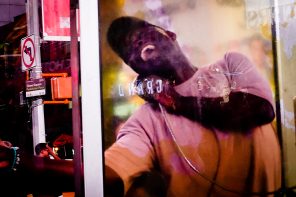Through the major museum exhibitions, professional photo journals, art fairs/contests, web site reviews, social network site prevalence and photo-book publishing by both independent publishers and by artists themselves in the last few years, Japanese photography has become very accessible to the western audience. It seems that its popularity continues to grow every year. I sometimes wonder if this Japanese photo craze can be compared with Japonism in Europe/US in the late 19th century, and I would like to introduce one short example of how they observed Japanese art back then:
“It is an art of feeling, or to put it in natural scientific terms, an art of nerves. It is built up completely from this basis; this is why it avoided chaos so instinctively, this is why it grew more organically than any other. For nothing is as fine as feeling. Therefore, an art of the nerves,,,,,,Just as European art is a creation of the mind, Japanese art is a creation of the nerves,,,,,,and since feeling is the most personal of all, Japanese art presents itself as the only true individual art.” (“The Spirit of Japanese Art”, Ver Sacrum I, 1898)
Against the conventional and restrictive academic art and mass-produced products of the industrial revolution, many avant garde artists/designers/intellectuals around the turn of the 20th century sought a new inspiration in art and life, and they found Japanese art as one of their strong creative vehicles. In Austria, for example, the influence of Japanese art was seriously considered by a group of artists known as The Vienna Secession, including Gustav Klimt, Josef Hoffmann, Joseph Maria Olbrich, Otto Wagner, Oskar Kokoschka, Koloman Moser, Egon Schiele and Rainer Maria Rilke, for achieving their ideal of new living “Gesamtkunstwerk” (a total work of art). As the official magazine of the Vienna Secession, Ver Sacrum (“Sacred Spring”) was published from 1898 to 1903. In the first issue, poet and art critic Ernst Schur wrote this essay to introduce Japanese aesthetics. As you can read, Schur clearly explained the difference of art between the West and Japan with an ardent enthusiasm and admiration.
I wonder if his view of Japanese art can be still relevant to our reaction to contemporary Japanese photographers, since the people I meet at Dashwood Books often express the same kind of excitement for their use of color, composition or subject matters. In addition, I think that Schur’s argument, that the essence of Japanese art was creation of the nerve (emotion) against western art’s creation of the mind (reason), might come from the difference of photography’s function in society; it is because photography in Japan has not evolved through history in the same way as in the West.
Especially in the US, educational, cultural and economic backgrounds accept and support all photographers/artists’ development as a united social function, and expression of photography mainly needs to be understood through discourse (logics) established by authority. In contrast, photography in Japan has remained independent from social factors and as a result, it inevitably relies on artist’s individual perception (regardless of intellectual or emotional). Therefore, Japanese photographers’ work remains less synthetic, detached, contrived or institutionalized; on the other hand, it stays rather natural, playful, personal and intrusive by appreciating his/her own experiences.
Looking at the eight young Japanese photographers’ work (Kenta Cobayashi, Motoyuki Daifu, Fumiko Imano, Yoshi Kametani, Momo Okabe, Hiroshi Takizawa, Naohiro Utagawa, and Daisuke Yokota) in the “New Material” exhibition catalogue by Casemore Gallery, SF and also getting a rare chance to talk with them at the opening, I can confirm that the less cohesive similarity among the works attests to their free artistic spirits, since each artist’s work fully enjoys expressing their own unique experience and understanding of their own world without intellectualizing any academic dogma.
Just like a Ukiyo e print amazed many French/American master painters and collectors over 120 years ago, I hope contemporary Japanese photography refreshes and stimulates our often too rationalized mind, and gives a new perspective of understanding about the things around us. I also hope that this exhibition catalogue, which presents work from many of the leading young Japanese photographers, will be an important resource for our artistic inspirations, and help us appreciate the cultural achievements of others with a sheer sense of enjoyment.
“New Material” exhibition catalogue by Casemore Kirkeby Gallery can be purchased here.
Miwa Susuda is Photobook Consultant at Dashwood Books, New York. She is Director of Session Press, introducing new work by contemporary Japanese and Chinese artists and lectured “Japanese Photography Book” at Visual Studies Workshop in 2016. As a contributing writer to Fraction Magazine Japan and diaSTANDARD, she interviewed Alec Soth, Mitch Epstein, Jim Goldberg, Jason Nocito, Michael Schmelling, Nick Waplington and Andreas Laszlo Konrath. Her writing includes “Photography and Language” for 10 x 10 American Photobook catalogue, “On Daido” for the exhibition catalogue for the 6th International Fotobookfestival in Kassel, Germany and “Ryan McGinley” and “Photojournalism and Photobook” in IMA Magazine, among many others. She is also a New York reporter for IMA Magazine and JP_EN 02 Special Judge for Einstein Studio in Tokyo.






